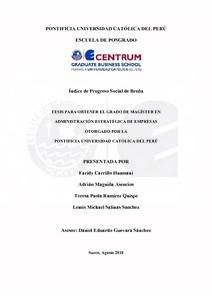Índice de progreso social de Breña

View/
Date
2018-09-23Author
Carrillo Huamani, Faridy
Maguiña Asencios, Adrián
Ramírez Quispe, Teresa Paola
Salinas Sanchez, Lemis Michael
Metadata
Show full item recordAbstract
La presente investigación tiene como objetivo calcular el Indicador de Desarrollo
Social del distrito de Breña y facilitar información de la situación actual del distrito en cuanto
a la percepción de bienestar de sus habitantes. Dicha información puede ser utilizada en la
gestión municipal y por otras instituciones públicas y privadas como una herramienta que les
permita desarrollar estrategias para mejorar la calidad de vida de los residentes. La
metodología de trabajo fue desarrollada por el Social Progress Imperative, y consiste en la
recopilación de data a través de encuesta como fuente primaria, e indicadores emitidos por
entidades públicas como fuentes secundarias. A nivel de ciudades, el Índice de Progreso
Social fue desarrollado por los profesores Michael Porter y Scott Stern.
El tipo de estudio de investigación con el que se trabajó es de enfoque cuantitativo,
descriptivo, y transaccional no experimental, que considera a las encuestas como método de
recopilación de datos. El tamaño de la muestra al que se aplicó la medición del Índice de
Progreso Social fue de 386 jefes de hogar del distrito de Breña en sus 4 urbanizaciones
geográficas.
Los resultados obtenidos bajo la metodología del Social Progress Imperative arrojaron
un puntaje de 56.84 para el distrito de Breña, que lo califica con un Índice de Progreso Social
de nivel medio bajo en el año 2017. La dimensión de Necesidades humanas básicas obtuvo
un puntaje de 65.62 que la califica con un nivel medio bajo debido principalmente a la
percepción de inseguridad dentro del distrito. Respecto de la dimensión Fundamentos de
bienestar Breña alcanzó un puntaje de 55.48. Finalmente, la dimensión Oportunidades obtuvo
el menor puntaje con 49.51. The objective of this research is to calculate the Social Progress Index of Breña,
district of Lima and also to provide information about the current situation of the district
regarding the perception of well-being of its inhabitants. This information can be used in
municipal management and by other public and private institutions as a tool that allows them
to develop strategies in order to improve the life quality of the residents. This methodology
was developed by the Social Progress Imperative, and it consists of the collection of data
through a survey which is the primary source. It is also allowed to use indicators issued by
public entities as secondary sources. The Social Progress Index was developed by professors
Michael Porter and Scott Stern at a city level too.
The type of research worked is quantitative, descriptive, and has a non-experimental
transactional approach, which considers surveys as a method of data collection. The size of
the sample to which the measurement of the Social Progress Index was applied was 386
heads of household in the district of Breña in its 4 geographical urbanizations.
The results obtained under the methodology of the Social Progress Imperative showed
a score of 56.84 for the district of Breña, which qualifies it with a low level of Social
Progress Index in the year 2017. The dimension of Basic human needs obtained a score of
65.52 that qualifies it with a low average level mainly due to the perception of insecurity
within the district. Regarding the dimension Fundamentals of well-being Breña reached a
score of 55.48. Finally, the dimension Opportunities obtained the lowest score at 49.51.
Temas
Indicadores sociales--Perú--Breña (Lima : Distrito)
Indicadores económicos--Perú--Breña (Lima : Distrito)
Investigación cuantitativa
Indicadores económicos--Perú--Breña (Lima : Distrito)
Investigación cuantitativa
Para optar el título de
Maestro en Administración Estratégica de Empresas
Collections
The following license files are associated with this item:





